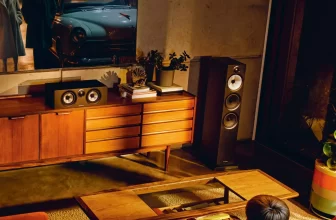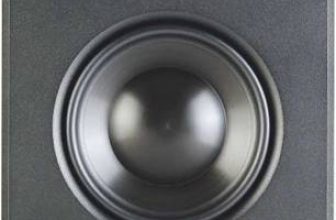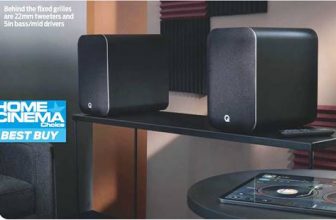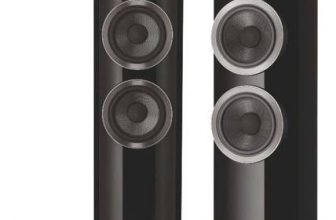Magico S7 floorstanding loudspeaker review
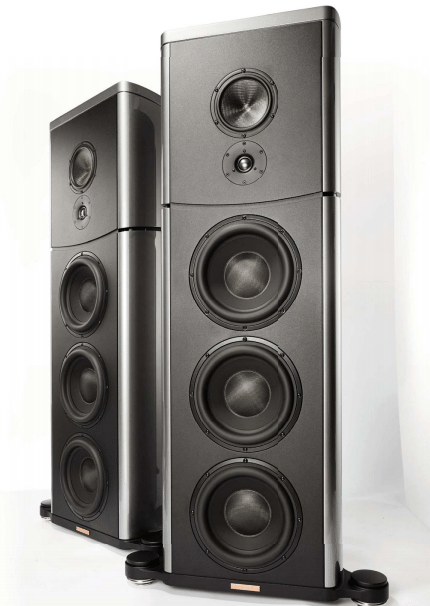
Now that Mágico is in its second decade, it’s time to both extend and redefine its lines. This can be a difficult task: the company’s S and Q lines have crossing points and products like the new S7 can cause some ‘which is better’ confusion. This is understandable because the Mágico S7 is a damn good loudspeaker, and the Mágico Q5 is a damn good loudspeaker, and they aren’t priced that far apart in the high-end’s upper slopes.

The S7 is the new top of the S-series, Magico’s more rounded (in all senses), more attainable line. The S7 was the first of Magico’s standard line of loudspeakers to feature the new diamond-coated beryllium tweeter, which is now filtering through the rest of the range. It’s a three-way tower loudspeaker, with the aforementioned 25mm tweeter, a wholly new 150mm midrange unit, and three 250mm aluminium-coned bass drivers. Both mid and treble are what might be considered ‘headline’ worthy drive units in their own right, and draw heavily from the M-Project, Magico’s limited edition, cost-no-object anniversary loudspeaker.
It would be extremely easy to dismiss that tweeter on first look. We’ve had diamond tweeters before and we’ve had beryllium tweeters before, so what’s the big deal? Well, we’ve only seen a diamond-coated beryllium tweeter once before, and that was in the M-Project. This is an ambitious project for any company, because the two are not natural partners. Diamond tweeters are notoriously difficult to use in audio, because their installation redefines ‘kid glove’ treatment -basically, look at a diamond tweeter in the wrong way and it will shatter. Once installed and away from prying fingers, it’s a dream material to work with, but I’ve spoken with designers who use diamond tweeters about using the material as a coating for beryllium, and they go through a few seconds of thinking that is a great idea, then they start rocking from side to side, pulling their hair out, and require restraining, medicating, and a 48-hour section. It’s not pretty.
OK, so M-Project is not the Manhattan Project, but Mágico found a way to use diamond as a coating for beryllium, which is in itself another dream material to work with (if you can work in a clean room with breathing apparatus – beryllium is safe to use as a tweeter material, but highly toxic to inhale when making those tweeters). This is impressive stuff, and what’s truly impressive is it is genuine trickle-down technology; first to the S7 and – by the time you read this – in the new versions of other S loudspeakers, including the S1 (Mk II), the first rung on the Mágico floorstanders ladder.
A lot of hi-fi loudspeaker companies, starting with KEF in the 1960s, make a big thing of material science, and how they use the latest technology in the construction of their loudspeaker drivers. Often, however, that ‘latest technology’ is decades old elsewhere, but new to the audio business. In the case of the S7’s midrange unit, you really are buying cutting edge technology, because this is one of the first practical commercial appearances of graphene. First discovered in 2004 by Andre Geim and Konstantin Novoselov at the University of Manchester, graphene is a two-dimensional material made of a single layer of carbon atoms arranged in a lattice. It won Geim and Novoselov knighthoods and Nobel Prizes (interestingly, Geim is the first individual to win both a Nobel Prize and an Ig Nobel Prize, the latter for levitating a frog with magnets in 2000). Graphene’s practical use is only now being realised, with the material appearing in designs of future semiconductors and batteries. Actual products in production that use graphene are currently exceptionally rare, with just an extremely expensive toner for printing and the midrange units in Mágico loudspeakers being the only commercial applications thus far.
The reason for the paucity of graphene in the marketplace comes down to one simple determinant – availability. The material is still made in ‘laboratory-conditions’ volumes, and that makes for both an extraordinarily expensive material, and something that cannot scale for significant numbers… yet. Flowever, the reason it’s so interesting and why graphene will be the material of the moment soon is that it is outstandingly strong, an excellent conductor of heat and electrons, and capable of creating very stiff, very light structures. In the case of the S7’s midrange unit, the cone material is a mix of multiwall carbon nanotubes and ‘nanographene’, and the resultant cone Is said to be 20% lighter and an astonishing 300% stiffer than previous designs.
After all that unobtanium in the treble and midranges, the three 250mm bass drivers are ‘simply’ aluminium coned affairs. That being said, the trio have extremely powerful magnets and those super-stiff cones have an impressive 15mm of linear movement, which is why they can deliver sound pressure levels of 120dB at 1 m at 50Hz.
The drive units are Impressive, but the cabinet and the crossover are hardly unimpressive. The S series uses a curved extruded aluminium cabinet and more conventional cross bracing, when compared to the Q models Internal ladderframe construction. This allows the mid and top sections to be almost completely chambered and therefore isolated from the bass section. A cabinet that has 13mm thick aluminium curved side walls, solid aluminium front baffle and rear panel, and sits on a very heavy outrigger spike arrangement, Is not exactly ‘just another box’, though. The S models have the ability to be finished In a range of six M-Cast powder and six M-Coat high gloss finishes at a premium, as well as a ‘none more black’ 2001 -style monolithic black as standard. A magnetic grill can be used, although Mágico recommends removing It for critical listening.
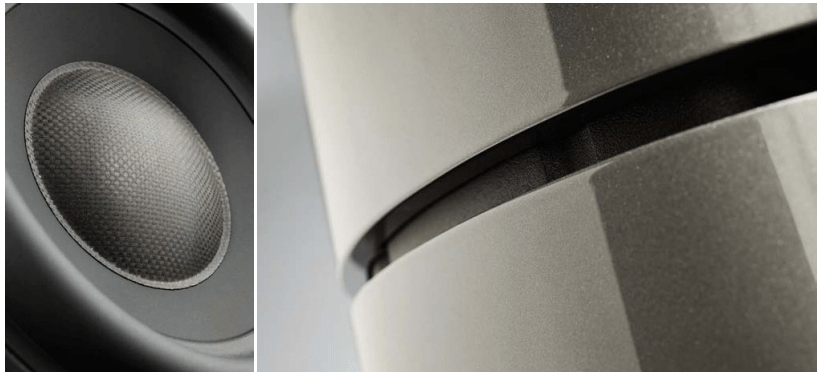
Mágico uses Its own ESXO (Elliptical Symmetry Crossover) network in all Its designs. This has an accelerated filter slope for each drive unit, allowing each unit to do its allotted task unimpeded by the other drivers In the system. This demands carefully selected components, and that’s why where other speakers might use Mundorf capacitors In the crossover, Mágico goes to Mundorf to specify unique MCap designs specifically for the brand. As ever, this can be put down to Mágico going the extra mile, and then a few hundred miles beyond that.
Although the S7 Is a flexible design in terms of load and prospective amplifier partners, the reality is the S7 Is made to rock out with a powerhouse amp feeding It. You can make some beautiful sounds with a well-engineered 50W valve amplifier (Mágico demonstrated the S1 [mk II] with Convergent Audio Technology power amps In Las Vegas this year, almost as a ‘screw you’ to the naysayers who think Mágico lives for solid state). But for the real deal, you need top-notch amplifier muscle. And Constellation Audio springs to mind, because they are perfect partners and because (In the UK at least), that’s the partnership you are most likely to hear. Coupled with a Perseus/Centaur II combination from Constellation’s Performance series, the Mágico S7 sings, and sings with a beautiful voice, that can also really kick!
A lot of high-end loudspeakers are Initially Impressive, only to pall after a while. Others are initially unimpressive, but ultimately satisfy In the long term. A tiny number are Initially Impressive and ultimately satisfying, and they are the best speakers money can buy. The S7 is one such loudspeaker.
Why it combines the Initially Impressive with the sustaining Is because It has an uncanny ability to play as well at polite listening levels as It does when It’s played at full thrash and all points In between. So, you go through the early “impress me!” phase, where you will end up playing something a bit ‘fruity’ (for me, that’s ‘La Grange’ by ZZ Top on Tres Hombres [London], played at ‘air drummer’ levels), and then gradually wick the volume back to sensible, then wig out, calm down, headbang again, chill out, and oscillate until you find your happy medium level. The S7 doesn’t just follow along with this, It Invites you to just keep oscillating, playing music loud and soft, finding the right level for each piece of music. Of course, this happens because the speaker doesn’t put a foot wrong tonally, from the deepest bass to the highest treble, it’s precise, powerful, and performance orientated!
The bass Is particularly Interesting, because It doesn’t necessarily draw attention to Itself, but It’s there in massive reserve when called upon. When you play a breathy singer/ songwriter, the S7 sounds all the world like a fast little two-way sealed box speaker. Move over to some dub reggae or electrónica and It’s like those little speakers were replaced with a jackhammer. Few loudspeakers ‘scale’ like the S7!
The loudspeaker is also satisfyingly detailed and extremely dynamic: two attributes that combine to draw out the most from even the darkest recesses of your music collection. OK, not the darkest recesses – that album by the Handless Organist is probably best left in the racks – but you really can throw everything your record collection has at the S7 and It comes out shiny, new, insightful, and interesting. You remember why you bought or downloaded that album you had all but forgotten. Even lo-fi Americana like Bonnie ‘Prince’ Billy’s ‘I See A Darkness’ from the album from the same name [Palace] Is transformed. Although I don’t recommend actually playing this through the S7, because the music is so harrowing, you might end up on suicide watch! Joking aside, this shows precisely why the S7 is so extremely good: it gets past the recording quality and straight into the core of the music in the way more ‘excitable’ loudspeakers do, but It also does so with all the detail and precision for which Mágico is justly famous.
There’s a Mágico meme that I kind of started – no magic in the Mágico – which was actually a compliment that lost its way. Mágico loudspeakers are fundamentally honest, wide-open transducers: what astonishes you about their performance Is It’s not their performance. Instead, it’s the sound of the musicians, and you almost Immediately realise that what we sometimes see as ‘magical’ in loudspeakers Is often simply a set of nicely tuned distortions. The S7 still has that Mágico integrity to its sound, but it also produces a sound that Is magical. Not in a ‘smoke-and-mirrors’ way, but you will listen enrapt for hours on end to these loudspeakers and come away smiling. Smiling in part because you still have that close connection with the recording studio, but also because the music is just enjoyable. This isn’t a volume thing – although it can get loud – it’s almost an atavistic thing. Sounds this deep, this open, and this civilised shouldn’t be this fun according to audio folklore. Mágico S7 begs to differ.
So, which is better… S7 or Q5? The two are different products for different end users, but that’s sitting on the fence. It was not logistically possible to hear the two side by side in anything like the same time-frame (that’s not simply a set-up issue, there are only a finite number of these loudspeakers in circulation in a country like the UK at any given time, and while sitting in front of a pair of S7s, every pair of Q5s in the country were already Installed In listeners homes). In a way, and this is going from memory, the Q5 Is the more ‘correct’ loudspeaker In that it is extremely accurate and faithful to what was laid down in the studio. The S7, in contrast, has a bit more magic in its presentation. If I had a pair of Q5’s, the S7 is probably not sufficiently different to justify the switch, but if I were listening to a Q5 and an S7 today, the S7 would be the one I’d take home. Although at 136kg per loudspeaker ‘take home’ probably involves a team of piano movers!
Mágico seems incapable of sitting still and resting on its laurels. This Is a great thing for audio enthusiasts, because each successive model, and each successive iteration of previous models, has been a step in the right direction. But amid all of that, the Mágico S7 represents something special. It’s the Mágico that puts the word ‘magic’ into that name at last, and effectively silences some of the counter arguments used against the marque. It’s that perfect combination of precision music listening tool and fun musical warhammer that we all want. Put simply, one of the best loudspeakers ever, and very highly recommended! +
TECHNICAL SPECIFICATIONS
Type: Three way, sealed box floorstanding loudspeaker Driver Complement: 1 x 25mm MBD26 Tweeter, 1 x 150mm MCG8005 Graphene midrange, 3 x 250mm aluminium cone bass units
Frequency Response: 20 Hz-50 kHz Sensitivity: 89dB Impedance: 4 Ohms Recommended Power: 50 -1,000 watts Finishes: Black, MCast (six colours, powder coat), MCoat (six colours high gloss paint finish)
Dimensions (HxWxD): 136.4×38.8×44.5cm
Weight: 136 kg per loudspeaker
Manufactured by: Mágico LLC URL: www.magico.net
Distributed by: Absolute Sounds


